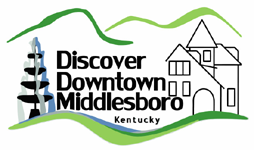 |
| Elaine Wilson with Kentucky Trail Town initiative meeting with leaders at Cumberland Gap National Historical Park. Credit: DDM. |
“Cumberland Gap is proud to welcome visitors from across the country and around the world,” said Acting Superintendent Diane Griffin. “We are delighted to share the story of this place and the experiences it provides and to use the park as a way to introduce our visitors to this part of the country and all that it offers. National park tourism is a significant driver in the national economy – returning $10 for every $1 invested in the National Park Service - and it’s a big factor in our local economy as well. We appreciate the partnership and support of our neighbors and are glad to be able to give back by helping to sustain local communities.”
Griffin further explains that this spending certainly complements the goal of Discover Downtown Middlesboro, Kentucky to achieve Trails Town designation. “This past Saturday, March 1st, Landscape Architect students from the University of Kentucky, working in conjunction with Discover Downtown Middlesboro Executive Director Isaac Kremer, unveiled a comprehensive trails plan for the town, with connectivity to the park, based upon tremendous creativity and foresight incorporating the arts, resource protection, visitor use and sustainability and certainly is geared to all user groups.”
Griffin also outlined an additional regional trails initiative involving not only Middlesboro, but also Pineville and Harlan, KY; Cumberland Gap and Harrogate, TN; Lincoln Memorial University (TN); Lee County, Virginia; Pine Mountain State Resort Park (KY) and the Pine Mountain Trail (KY); Wilderness Road State Park (VA); the Cumberland Trail (TN); and the Great Eastern Trail, the long distance trail which will
connect Alabama to New York. “Working cohesively with all these groups, imagine the multiplier effect of this $50.3 million as folks extend their visits and participate in other activities offered in the area.”
The peer-reviewed visitor spending analysis was conducted by U.S. Geological Survey economists Catherine Cullinane Thomas and Christopher Huber and Lynne Koontz for the National Park Service. The report shows $14.7 billion of direct spending by 283 million park visitors in communities within 60 miles of a national park. This spending supported 243,000 jobs nationally, with 201,000 jobs found in these gateway communities, and had a cumulative benefit to the U.S. economy of $26.75 billion.
According to the report most visitor spending supports jobs in restaurants, grocery and convenience stores (39 percent), hotels, motels and B&Bs (27 percent), and other amusement and recreation (20 percent).
To download the report visit http://www.nature.nps.gov/socialscience/economics.cfm
The report includes information for visitor spending at individual parks and by state. To learn more about national parks in Kentucky, Tennessee and Virginia and how the National Park Service works with communities to preserve local history, conserve the environment, and provide local recreation opportunities, go to www.nps.gov/kentucky,
www.nps.gov/tennessee or www.nps.gov/virginia.

No comments:
Post a Comment